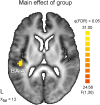Auditory Deficits in Audiovisual Speech Perception in Adult Asperger's Syndrome: fMRI Study
- PMID: 31649597
- PMCID: PMC6795762
- DOI: 10.3389/fpsyg.2019.02286
Auditory Deficits in Audiovisual Speech Perception in Adult Asperger's Syndrome: fMRI Study
Abstract
Audiovisual (AV) integration deficits have been proposed to underlie difficulties in speech perception in Asperger's syndrome (AS). It is not known, if the AV deficits are related to alterations in sensory processing at the level of unisensory processing or at levels of conjoint multisensory processing. Functional Magnetic-resonance images (MRI) was performed in 16 adult subjects with AS and 16 healthy controls (HC) matched for age, gender, and verbal IQ as they were exposed to disyllabic AV congruent and AV incongruent nouns. A simple semantic categorization task was used to ensure subjects' attention to the stimuli. The left auditory cortex (BA41) showed stronger activation in HC than in subjects with AS with no interaction regarding AV congruency. This suggests that alterations in auditory processing in unimodal low-level areas underlie AV speech perception deficits in AS. Whether this is signaling a difficulty in the deployment of attention remains to be demonstrated.
Keywords: Asperger’s syndrome; audiovisual; autism; fMRI; multisensory; speech.
Copyright © 2019 Tietze, Hundertmark, Roy, Zerr, Sinke, Wiswede, Walter, Münte and Szycik.
Figures


References
-
- American Psychiatric Association (2000). Diagnostic, and Statistical Manual of Mental Disorders DSM-IV, 4th rev. Edn Washington, DC: American Psychiatric Publication.
-
- American Psychiatric Association (2013). Diagnostic and Statistical Manual of Mental Disorders. DSM-5, 5th Edn Washington, DC: American Psychiatric Publication.
-
- Baayen R. H., Piepenbrock R., Van Rijn H. (1993). The CELEX Lexical Data Base on CDROM. Philadephia, PA: Linguistic Data Consortium; https://catalog.ldc.upenn.edu/docs/LDC96L14/celex.readme.html (accessed September 28, 2019).
LinkOut - more resources
Full Text Sources
Research Materials

